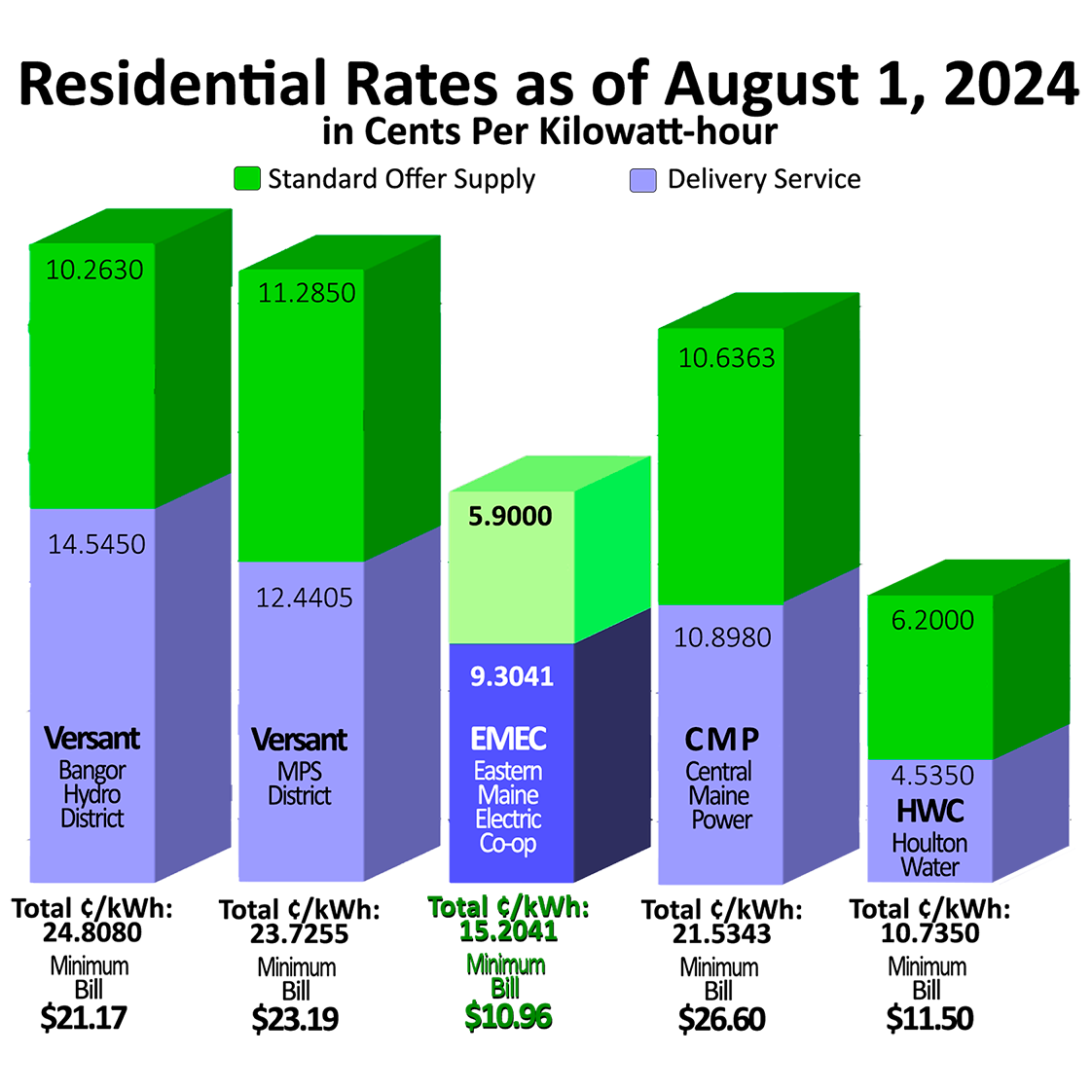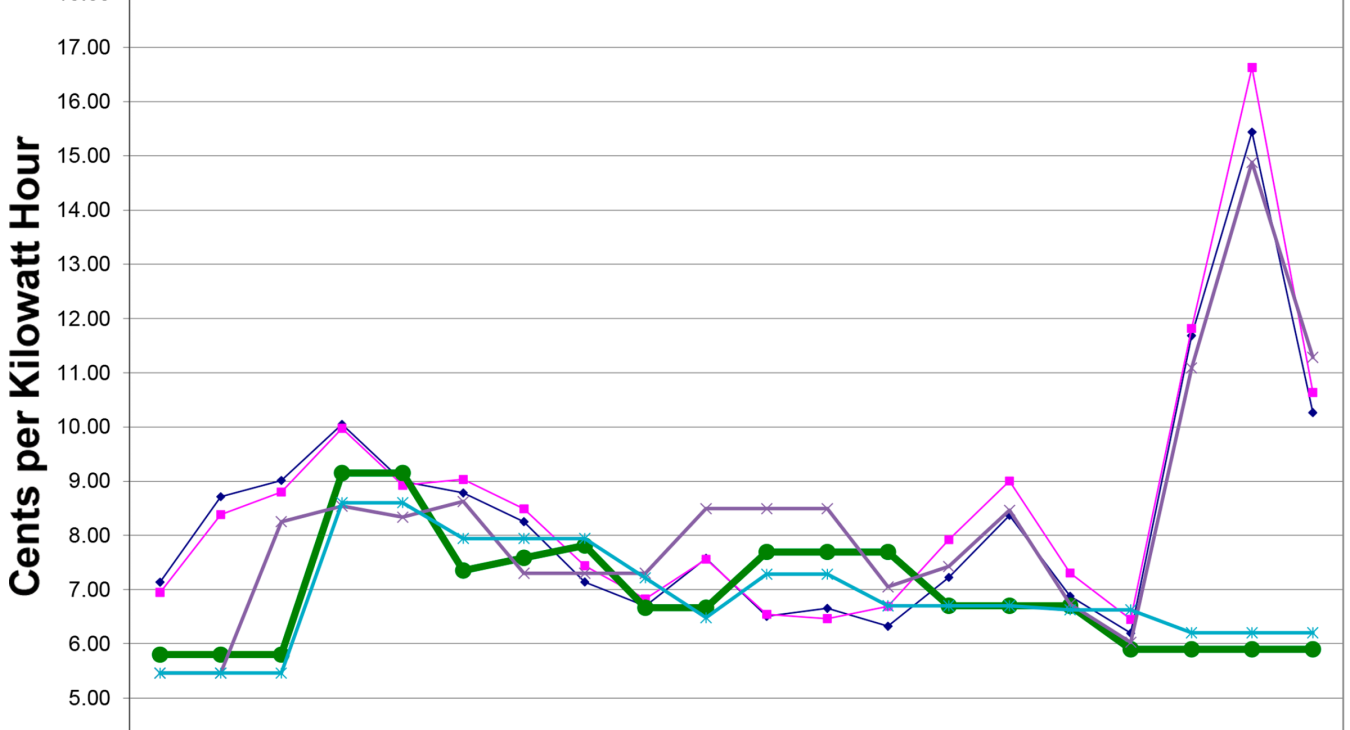Residential Standard Offer Prices
Eastern Maine Electric’s 2024 Annual Meeting was held at Washington County Community College on Saturday, July 20th, one of the best weather days of the year. A total of 234 members took part in the meeting.
EMEC Board President Scott Skinner updated the members with operational developments from the past year. Among other things, including the storm that began December 18, 2023, which cost $1.3 million. “If the Co-op had to recover the cost of the December storm in future electric rates, the impact would be painful,” he said. “We are fortunate, though. As a private non-profit, Eastern Maine Electric qualifies for storm recovery assistance from the Federal Emergency Management Agency (FEMA).” The storm costs not covered by FEMA will be approximately $200,000.
President Skinner also described a coincidence involving one of this year’s member welcoming gifts.
In January, the Co-op had decided to include in the Annual Meeting gift bags a limited-production coin from the US Mint as part of their American Innovation series of coins. All fifty states will have one innovation highlighted by the series. The Maine coin was issued in 2024, so it seemed like a timely gift.
Then this spring, EMEC’s linemen applied life-saving measures using an Automatic Electronic Defibrillator (AED) from their bucket truck, saving the life of a local man. “This brings me back to the coincidence I mentioned before,” President Skinner said. “The honoree of the coin you received today is the Maine cardiologist who invented the direct-current defibrillator in 1961. It was an early version of the unit our linemen would use to save a local man’s life sixty-three years later.”
Electric cooperatives from 44 states send over 1,500 students to Washington D.C. to attend the Youth Tour. The students learn about history, government, and leadership. They also meet with elected officials and/or their staff. One student from each participating state is selected to serve on the national Youth Leadership Council (YLC).
Sarah London, a senior at Southern Aroostook Community School, was chosen as Maine’s YLC delegate. She discussed her experience at the Youth Tour this June.
“I knew I would have a great time in D.C.,” she said, “but what made it a different kind of adventure, was experiencing it with kids who have lived different lives and have different insights.”
She concluded, “So many thank you’s to EMEC for this opportunity, and I feel so fortunate to be able to represent you all in the coming months as your YLC representative.”
CEO's Report: What's Ahead
The Co-op’s Chief Executive, Scott Hallowell, began his report with a discussion of Net Energy Billing (NEB), beginning with an explanation of the term.
What is NEB?
When electric consumers have renewable generation installed behind the meter, NEB is the billing process that tracks the exports and imports between a consumer and the electric utility. Solar units are the most common type of renewable generation.
Solar units seldom, if ever, generate exactly the number of kiloWatt-hours (kWhs) a home or business needs. If the unit generates too little electricity, then some kWhs are imported from the utility. When a solar unit generates more than is needed, that surplus power is exported to the utility’s system.
These imports and exports are metered by the electric utility. The consumer is billed for imports from the utility, and credits are issued for a consumer’s exports to the utility.
“To be clear,” Hallowell said, “the Co-op is not opposed to solar being installed at houses. However, the Co-op has always had concerns about the legislation and rules regarding NEB.” While solar units reduce some costs for consumers with solar installed, the present NEB practice actually shifts costs among the Co-op’s members, which is not equitable.
“When a consumer exports electricity to the utility, credits should be issued at some level of the Standard Offer supply price, but there should not also be credits issued equal to the delivery rate, as is happening now. Here is why.”
He continued, “Whether importing or exporting electricity, a consumer is still using the delivery system. The electricity is just flowing in different directions, and the cost of operating the system is not reduced. Providing credits for delivery service reduces revenue to the Co-op without reducing the cost.”
Hallowell offered an analogy of two cars traveling on Interstate 95 where the cost of operating the highway is covered by tolls collected.
Hallowell said, “If the Interstate was run by rules similar to NEB rules, both cars would pay a toll to use the interstate going south. On their return trip north, though, only one of the cars would pay the toll. The other car would receive a slip with toll credits that could be used the next time the car travels south.
“The cost to maintain and operate the interstate has not changed, but there is less toll revenue being collected to cover those costs. In the end, toll charges would have to increase to cover the shortfall caused by issuing the credits.”
Eastern Maine Electric, as a consumer-owned utility, is exempted from parts of the net energy billing legislation that applies to Central Maine Power and Versant Power.
“As a result,”Hallowell said, “while the Co-op incurs some costs from net energy billing, EMEC’s costs are a lesser magnitude of those impacting CMP and Versant. To cover their NEB-related costs, the two investor-owned utilities will need to collect in the range of $200 million from their customers over the next year.”
Hallowell said the Co-op and the state’s other consumer-owned utilities have tried without success to get the legislation and rules changed to eliminate providing delivery credits under net energy billing.
Cost Pressures and Upcoming System Improvements
Hallowell also discussed the continuing inflation-related cost pressures on the Co-op. Using pole top transformers as an example, he said, “The cost of a 10 kVA transformer was $770 in 2019. That increased to $1,330 this year: a 72% increase.”
The CEO pointed out the Co-op has several large system-improvement projects planned, with large expenditures that would be impacted by inflation.
For example, Versant Power, who owns the transmission line that serves EMEC’s Patten and Ludlow substations, will be increasing the voltage on that line. This will require EMEC to replace two substation transformers at approximately $450,000 each.
The Co-op is also in the midst of a years-long project of rebuilding the 69 kV transmission line serving four of its substations. The next planned phase of that project involves rebuilding about eight miles of transmission line in Baileyville and Princeton. The cost of this reconstruction is presently about $1 million per mile.
Hallowell explained how the Co-op is doing all it can to defray these costs. “The Co-op has applied for a federal grant that, if awarded, would cover approximately 50% of the project cost.” This is not the only way the Co-op is working to improve the electric grid while keeping costs down.
“The Co-op has also applied for a grant through the State of Maine to rebuild ten miles of distribution lines along Routes 191 and 214 between Cooper and Charlotte,” he said. “The project would cost about $3 million, and the grant would cover $2 million of funding.” Subsequent to the Annual Meeting, the Co-op received a conditional award of the grant, pending final U.S. Department of Energy review and the finalization of contract negotiations.
In addition to increasing the reliability of that ten-mile section, this project would increase the areas that could be backfed from more than one substation. This would give the Co-op more flexibility for rerouting power during emergencies.
Delivery Rate Increase
“Everything I have been talking about only underscores the need for additional delivery revenue to operate the Co-op and make these necessary improvements,” the CEO said.
He added, “The amount of the increase is still being evaluated, as is the change to the customer charge, the per-kWh charge, or a combination of the two. The average impact on residential members will be in the range of $8.25 per month.”
The customer charge is designed to collect revenue for costs that don’t change based on how much electricity someone uses. As an example, the CEO pointed out that infrastructure for serving seasonal homes costs as much as the infrastructure for full-time residences, even though most seasonal homes use relatively few kWhs compared to full-time residences.

“This is why the seasonal customer charge is a little more than the residential charge,” Hallowell explained.
He concluded, “Increasing rates is not something the Co-op takes lightly. We have put it off as long as we have been able to.” The last delivery rate increase was in 2019.
“We will give you more information in the next couple of months,” he said. “We expect the new delivery rates to be in place by the end of the year.”
Standard Offer Supply
Another subject discussed by CEO Scott Hallowell was the Standard Offer Supply pricing. “We have all enjoyed a much lower Standard Offer electricity supply price than the other utilities in the state,” he said. “In 2020, when electricity markets were at a low point, the Co-op secured a five-year contract with New Brunswick Power for a price of 5.9 cents per kilowatt-hour. This contract ends in October 2025.”
He continued, “The five-year contract was the longest we could get. Shortly after that, the cost of electricity supply began to rise dramatically.”
He compared EMEC’s supply price since 2020 with that of Versant’s Maine Public Service district. While EMEC’s Standard Offer price has stayed at 5.9 cents, Versant’s price rose to 14.8 cents, before eventually dropping back to 11.3 cents in 2024, a price that is still over 91% higher than Co-op members pay.
“For 2022, 2023, and 2024, this lower supply price will have saved EMEC’s members a total $19.8 million” the CEO said. “In those three years,the average Co-op member, using 600 kwhs per month, will have saved over $1400.”
While the present Standard Offer price will expire at the end of October 2025, the Co-op continues to monitor the markets for the timing to lock in the next price.
“Unfortunately,” he continued, “based on the market today, it looks like the new price will be higher. In the meantime, we will continue to enjoy the below-market price of 5.9 cents.”
-END-




